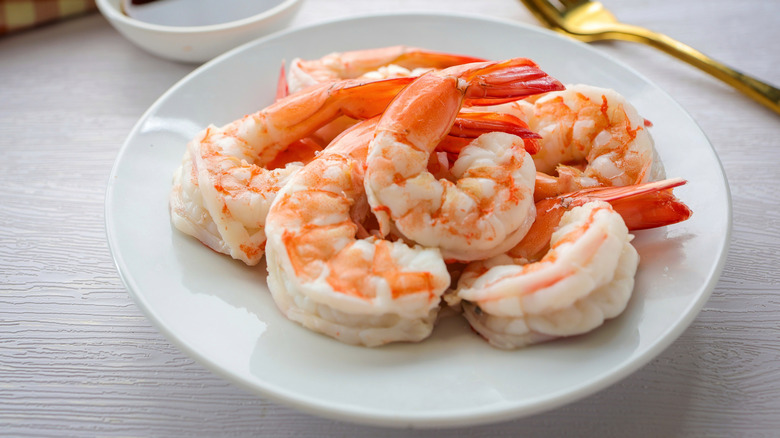Here's Why Shrimp Turn From Gray To Pink Once Cooked
Shrimp — the most consumed seafood in the United States. Whether throwing these little flavor powerhouses into some gumbo (with microwaved roux) or shrimp and grits (with popcorn), we eat a lot of shrimp. But as anyone who has dealt with raw shrimp before knows, these little crustaceans are a blue-gray color when raw, and then turn pink when cooked.
Turns out it has to do with breaking the bonds of protein chains. Everyone's favorite! Basically, inside a shrimp's exoskeleton is a carotenoid compound called astaxanthin. For those who skipped chemistry, like moi, carotenoids are simply a class of fat-soluble pigments that are typically some kind of yellow, orange, or red color. You might recognize a more famous carotenoid: beta carotene, the compound in carrots that gives them their color and, when consumed, is converted to vitamin A. (It being fat-soluble means you should eat your carrots with a little fat, though not too much).
Unlike beta carotene, astaxanthin doesn't turn into vitamin A when metabolized. When astaxanthin is in a raw or live shrimp, it's actually surrounded by a protein chain called crustacyanin. This protein chain binds to astaxanthin. These bonds are not super stable, chemically speaking, meaning the bonds break pretty easily in the presence of heat. Once those bonds are broken, astaxanthin is released, and voila — pink shrimp.
Selecting the best shrimp at the store
Buying shrimp is actually an overwhelming experience. Because it is so popular, there are many types and brands you can get. Shrimp is highly perishable and spoils easily, which is why even when you're buying "fresh" shrimp at the store, it's almost always been previously frozen and then thawed at the store. Only if you live along the coast and buy directly from fishermen will fresh shrimp be a true option for you. If you're lucky enough to go that route, look for shrimp that still have heads and smell fresh, and maybe a little like the ocean. Avoid any shrimp that have little black spots on their heads, called melanosis. This means they're not at their freshest. As with any seafood, if it smells fishy, do not buy it.
For most of us, frozen shrimp will be the best way to go. Most of the shrimp available will be farm-raised, but you can find wild-caught if you look hard enough. (If sustainability is important to you, look for labels like the Marine Stewardship Council.) They're often flash frozen when they're caught or harvested, and retain their taste pretty well. Texture-wise, it will depend on how you cook them. It's probably best to get individually quick frozen (IQF) shrimp that are already deveined. Individually quick frozen shrimp is typically higher in quality and easier to use, and shrimp that's been deveined takes the hassle out of you having to! However you like to get your shrimp, these little pink guys remain wildly popular.

